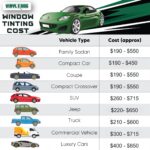American drivers are on the road a lot. In 2022, they averaged about 60 minutes driving 30 miles each day. Interestingly, despite this reliance on vehicles, new car sales have been decreasing since 2018 due to rising costs of car ownership, including higher loan interest rates and insurance premiums. While there was a slight sales increase in 2021, 2022 saw the lowest sales figures in a decade. However, the total number of cars on US roads has still increased, growing from approximately 276 million in 2020 to 282 million in 2021. In 2022, a staggering 255 million American drivers spent a total of 93 billion hours behind the wheel. This raises the question: just how many cars are in the US and what does car ownership look like in America today?
U.S. Car Ownership Overview
As of 2021, there were a remarkable 283,400,986 registered vehicles in the United States. This figure includes both commercial and personal vehicles. Specifically, 278,870,463 of these were private and commercial vehicles, with the remaining 4,530,523 being publicly owned. According to data from the 2021 U.S. Census Bureau, car ownership is widespread. A significant 91.7% of U.S. households own at least one vehicle, and notably, nearly 22% of households possess three or more vehicles. This high rate of ownership is consistent with previous years, with 91.5% of households owning at least one vehicle in 2020. Furthermore, traffic volume continues to increase, with 2023 showing a 1.3% increase compared to 2022, measured between October of both years.
When it comes to personal vehicle preference, crossover SUVs are the most popular choice, accounting for 45% of all U.S. auto sales as of June 2022. Popular models in this category include the Honda CR-V, Toyota RAV4, and Nissan Rogue. In addition to SUVs, pickup trucks are also a significant part of the vehicle landscape, with 808,000 registered pickup trucks reported in the U.S. Census Bureau’s 2021 Vehicle Inventory and Use Survey.
Trends in Car Ownership Over Time (2018-2022)
Looking at car ownership trends over recent years, the number of U.S. households owning at least one vehicle has generally been on the rise. From 111,132,564 households in 2018, the number increased to 119,130,346 in 2022. This represents an overall increase of approximately 7.2% in car-owning households. The year 2020 was an exception, likely due to reduced driving needs during COVID-19 lockdowns. However, there was a significant rebound between 2020 and 2021, with a nearly 5% jump in households owning at least one vehicle, reflecting the renewed importance of personal transportation as restrictions eased.
The Increasing Costs Associated with Car Ownership in the U.S.
The expenses associated with owning a car in the United States are climbing. Annual car ownership costs saw a substantial increase of over 13% between 2022 and 2023, reaching a total of over $12,182.
One major factor contributing to this rise is the average auto loan interest rate, which in 2023 jumped to 7.2%. This is a two percentage point increase year-over-year and represents the highest rate since 2007. Adding to the financial burden, vehicle repair costs also surged by 17% between August 2022 and August 2023, despite easing inflation in other sectors. Even routine maintenance tasks like oil changes experienced a 9% price increase during the same period. These mounting costs, combined with higher auto loan interest rates and increasing property and casualty (P&C) insurance premiums, may be influencing car purchasing decisions, particularly among younger generations.
Data suggests that roughly half of all U.S. automobile owners are over the age of 60. However, as Generation Z enters adulthood, they are expected to become a significant driver in the auto market. Currently, 35% of Gen Z individuals do not own a car, and they comprise a substantial 63% of prospective auto shoppers, indicating a potential shift in car ownership demographics in the coming years.
Vehicle Registration by State
The states with the highest numbers of registered vehicles are California, Texas, Florida, Ohio, and Pennsylvania. This generally correlates with states that have large populations and/or more limited public transportation options, making car ownership a necessity for many residents.
Conversely, Washington, D.C., Delaware, Vermont, Alaska, and Rhode Island have the fewest registered vehicles. This is often due to a combination of smaller state populations and, in some cases, more robust public transit systems, especially in densely populated metropolitan areas within these states, which can reduce the need for individual car ownership.
FAQ
How many licensed drivers are there in the U.S.?
In 2023, it was estimated that there were 243.3 million licensed drivers in the United States.
How many vehicles were sold in 2022?
The U.S. auto industry sold 2.86 million cars in 2022.
How many cars are in the world in 2023?
It is projected that by the end of 2024, there will be 1.5 billion cars worldwide.
Which country has the most cars per capita?
New Zealand currently holds the highest number of cars per capita at 0.9 vehicles per person, closely followed by the U.S. at 0.89 vehicles per capita.
References
https://www.consumeraffairs.com/news/credit-cards/
https://www.consumeraffairs.com/news/the-cost-of-driving-a-car-continues-to-rise-101123.html

